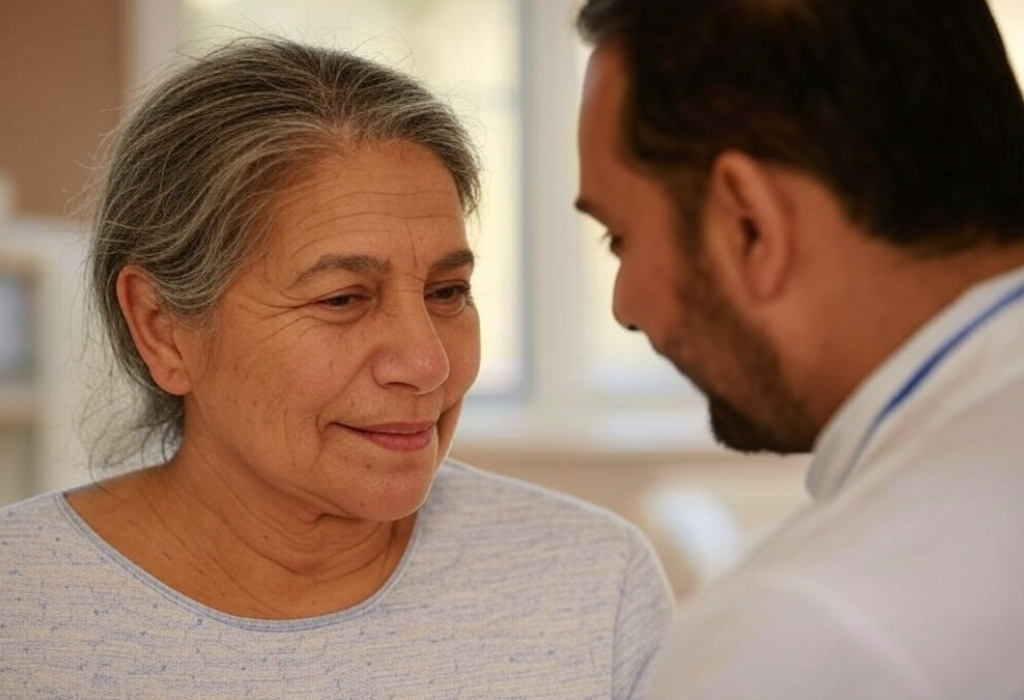In the U.S., a comprehensive healthcare system includes the segment of primary care, with women’s health services in primary care playing a pivotal role. These services, often provided through women’s health centers, are tailored to meet the specific and unique needs of women. The milestones and life stages that women experience—from menstruation, pregnancy, lactation, and menopause, to older age when they are more likely to develop chronic diseases—require scalable interventions that are both timely and effective at each stage of life.
At RGV Direct Care, we specialize in providing personalized and integrative primary care services, including women’s health. Led by Dr. Fausto M. Escobedo, a board-certified family physician, our clinic combines traditional medicine with holistic treatments to address unique health challenges. Located in Weslaco, TX, we accept most major insurances and are committed to delivering accessible, high-quality care tailored to every stage of life.
The Importance of Women’s Health Services in Primary Care
Women’s health services address unique needs across a woman’s lifespan, from adolescence to menopause and beyond. Primary care settings provide accessible, continuous, and gender-specific healthcare.
Preventive screenings like Pap smears, mammograms, and bone density tests are vital for early detection of conditions like cervical cancer, breast abnormalities, and osteoporosis. These screenings help prevent serious health issues.
Reproductive health services include contraceptive counseling, preconception care, and menstrual disorder management, addressing conditions like PCOS and endometriosis. These services empower women to make informed decisions about their health.
Mental health support is integrated into primary care, addressing higher rates of depression and anxiety in women. Providers offer first-line treatments or referrals, reducing stigma and improving adherence.
Chronic disease management focuses on gender-specific conditions like heart disease, autoimmune disorders, and thyroid issues, ensuring regular monitoring and care.
Access to comprehensive women’s health services reduces emergency visits, improves outcomes, and lowers costs through early intervention, enhancing satisfaction and adherence to care.
Essential Women’s Health Services Provided in Primary Care

Primary care offers preventive care, reproductive health, and age-specific interventions tailored to women’s needs.
Preventive Screenings and Examinations
Screenings like blood pressure checks, cholesterol tests, mammograms, Pap smears, and bone density tests detect health issues early, preventing progression to serious conditions.
Reproductive Health Services
Services include contraceptive counseling, preconception care, STI testing, and initial prenatal care coordination. These empower women to make informed reproductive health decisions.
Menopause Management
Providers address symptoms like hot flashes and sleep disturbances with lifestyle changes or medication. Preventive care focuses on heart disease and bone health, while addressing vaginal dryness and sexual health concerns.
Challenges in Accessing Women’s Health Services
Despite their importance, many women face barriers to accessing care, impacting health outcomes.
Geographic and Economic Barriers
Women in rural areas often travel long distances for care, with 49% of U.S. counties lacking an OB-GYN. Economic barriers like being uninsured or high out-of-pocket costs deter care, disproportionately affecting low-income women and women of color.
Cultural and Communication Issues
Language barriers and cultural taboos hinder care access. A lack of diverse providers exacerbates these issues, as women prefer discussing intimate concerns with culturally sensitive providers.
Integrating Women’s Health into Primary Care Models
Primary care models increasingly integrate women’s health services for holistic care.
Patient-Centered Medical Homes
PCMHs coordinate care across providers, improving outcomes and satisfaction. They emphasize comprehensive, patient-centered, and accessible care, increasing preventive screening rates.
Team-Based Approaches
Team-based care involves interdisciplinary collaboration, enhancing efficiency, screening rates, and chronic disease management. Clear communication and shared records ensure success.

Essential Women’s Health Services Provided in Primary Care
Primary care serves as a central hub for women’s health services, offering comprehensive care tailored to women’s unique health needs. These services span preventive care, reproductive health, and age-specific interventions that support women throughout their lives.
Preventive Screenings and Examinations
Preventive screenings form the foundation of women’s primary care services. Regular blood pressure checks detect hypertension early, while cholesterol screenings identify cardiovascular risk factors common in women. Primary care providers also perform breast examinations and recommend mammograms based on age and risk factors. Cervical cancer screenings through Pap smears and HPV testing remain crucial preventive measures for women ages 21-65. Bone density tests help identify osteoporosis risk, particularly after menopause when bone loss accelerates. These screenings allow for early detection of health issues before they progress to more serious conditions.
Reproductive Health Services
Reproductive health services address women’s needs across their reproductive years. Primary care physicians provide contraceptive counseling, helping women choose appropriate birth control methods from pills to long-acting options. Preconception care prepares women planning pregnancy through nutritional guidance, supplement recommendations, and health optimization. STI testing and treatment protect reproductive health and prevent complications like pelvic inflammatory disease. Pregnancy testing and initial prenatal care coordination often begin with the primary care provider, who then works with obstetric specialists for ongoing management. These services empower women to make informed decisions about their reproductive health while maintaining optimal wellness.
Menopause Management
Menopause management addresses the physical and emotional changes women experience during this transition. Primary care providers monitor and treat symptoms such as hot flashes, night sweats, and sleep disturbances through lifestyle modifications and medication when appropriate. Hormone therapy options are discussed based on individual health profiles, symptoms, and risk factors. Preventive care during this phase includes intensified screenings for heart disease, which becomes more prevalent after menopause. Primary care physicians also address vaginal dryness, urinary symptoms, and sexual health concerns that commonly occur during this life stage. Nutritional guidance focuses on preventing weight gain and maintaining bone health through calcium and vitamin D intake.
Challenges in Accessing Women’s Health Services
Despite the importance of comprehensive women’s health services in primary care, many women face significant barriers to accessing these essential services. These challenges stem from various factors that limit healthcare accessibility and potentially compromise women’s overall health outcomes.
Geographic and Economic Barriers
Geographic limitations create substantial obstacles for women seeking healthcare services. Women in rural areas often travel more than 30 miles to reach the nearest provider offering specialized gynecological care. This distance barrier becomes particularly problematic for time-sensitive services such as contraceptive access or pregnancy care. The shortage of providers in non-urban communities compounds these issues, with 49% of U.S. counties lacking a single OB-GYN provider.
Economic considerations present equally challenging barriers. Many women in the United States remain uninsured, limiting their access to routine preventive services. Those with insurance frequently encounter high deductibles and copayments, making necessary care financially burdensome. A 2022 Kaiser Family Foundation study found that 38% of women delayed or skipped medical care due to cost concerns. These financial constraints disproportionately affect low-income women and women of color, creating significant healthcare disparities.
Cultural and Communication Issues
Cultural barriers significantly impact women’s comfort and willingness to seek care. Language differences between patients and providers create communication challenges for approximately 25 million women with limited English proficiency. Without adequate interpretation services, these women receive incomplete information about their health options and care instructions.
Religious and cultural beliefs influence how women approach healthcare services. Some communities maintain strong cultural taboos around discussing reproductive health, deterring women from seeking necessary screenings or treatments. Healthcare systems frequently lack culturally sensitive approaches, with 67% of women from minority backgrounds reporting at least one negative experience related to cultural insensitivity during medical visits.
The shortage of diverse healthcare providers exacerbates these issues. Women express greater comfort discussing intimate health concerns with providers who share or understand their cultural background. However, only 2% of OB-GYNs identify as Black, and 7% as Hispanic, compared to the much more diverse patient population they serve. This representation gap creates additional barriers to establishing trusting patient-provider relationships that facilitate comprehensive women’s health care.
Integrating Women’s Health into Primary Care Models

Primary care models increasingly embrace comprehensive women’s health services to deliver holistic care that addresses unique female health needs. These integrated approaches maximize healthcare efficiency while enhancing patient outcomes through coordinated service delivery systems.
Patient-Centered Medical Homes
Patient-Centered Medical Homes (PCMHs) represent an evolved primary care model that places women at the center of their healthcare experience. PCMHs coordinate care across multiple providers, creating a unified health management system tailored to individual needs. This model demonstrates significant benefits for women’s health, with research showing 20-30% reductions in emergency department visits among female patients enrolled in PCMH programs.
The PCMH framework incorporates five key elements for effective women’s health integration:
- Comprehensive care spanning preventive screenings, reproductive health, and chronic condition management
- Patient-centered approaches honoring women’s unique preferences, cultural backgrounds, and life circumstances
- Coordinated services connecting primary care with specialty providers, including OB/GYNs and mental health professionals
- Accessible services offering extended hours, telehealth options, and same-day appointments
- Quality improvement through data-driven assessments focused on women’s health metrics
Women who participate in PCMH models report 15% higher satisfaction rates compared to traditional care structures. These integrated systems track preventive screening completion rates, resulting in 25% higher mammography and Pap test compliance among enrolled patients.
Team-Based Approaches
Team-based care transforms how primary care practices deliver women’s health services by assembling professionals with complementary expertise. Effective teams typically include physicians, nurse practitioners, physician assistants, registered nurses, and medical assistants working collaboratively toward shared patient goals.
This collaborative approach offers numerous advantages:
- Enhanced expertise through interdisciplinary knowledge sharing about women’s health concerns
- Improved efficiency with appropriate task distribution, allowing physicians to focus on complex cases
- Increased screening rates as multiple team members can identify and address preventive care needs
- Better chronic disease management for conditions like osteoporosis and autoimmune disorders
- Expanded access to care through strategic deployment of team members
Primary care practices implementing team-based models report 40% improvements in timely follow-up for abnormal screening results and 35% increases in completed preventive services for female patients. Each team member contributes unique skills—nurses often excel at patient education about reproductive health, while behavioral health specialists address mental health concerns like postpartum depression.
Successful team integration requires clear communication protocols, regular case conferences focused on complex women’s health cases, and shared electronic health records that highlight female-specific preventive care needs. Practices with established team-based approaches demonstrate lower provider burnout rates while maintaining higher patient continuity, particularly important for women seeking consistent reproductive and preventive care.
Conclusion
Women’s health services in primary care improve outcomes through integrated, patient-centered models and technology. Addressing barriers and implementing evidence-based policies will enhance access and care quality, benefiting individuals and communities. Women’s health services represent a cornerstone of comprehensive primary care in the United States. From preventive health screenings to acute illness management, these essential services help identify potential health concerns early when they’re most treatable.
Primary care providers serve as the first point of contact for women seeking healthcare, offering critical services like blood pressure monitoring, cholesterol checks, and diabetes testing. They’re also equipped to handle sudden illnesses and provide valuable health education focused on nutrition, exercise, and lifestyle choices that promote long-term wellbeing.
Regular engagement with primary care services empowers women to take control of their health through early detection and prevention strategies. These foundational healthcare services create a strong base for maintaining optimal health throughout every stage of life.
Frequently Asked Questions
What are essential women’s health services in primary care?
Essential women’s health services in primary care include preventive screenings (Pap smears, mammograms, bone density tests), reproductive health services (contraceptive counseling, preconception care), chronic disease management, and mental health support. Regular screenings for blood pressure, cholesterol, and cervical cancer are also fundamental components, along with age-specific interventions and menopause management. These comprehensive services form the foundation for maintaining optimal health throughout a woman’s life.
How does regular engagement with women’s health services improve health outcomes?
Regular engagement with women’s health services improves outcomes through early detection and prevention of health issues. This proactive approach allows for timely interventions before conditions become serious, reduces healthcare costs, and increases patient satisfaction. Consistent care establishes a trusting relationship with healthcare providers, enabling better management of chronic conditions and addressing women’s unique health needs at each life stage.
What barriers do women face in accessing health services?
Women face several significant barriers to accessing health services, including geographic limitations (especially in rural areas where specialized care may be 30+ miles away), economic obstacles like being uninsured or facing high deductibles, and cultural/communication challenges. Language differences and cultural taboos can deter women from seeking care, while the shortage of diverse healthcare providers further complicates access, as women often prefer discussing intimate health concerns with providers who understand their cultural background.
What is a Patient-Centered Medical Home (PCMH) and how does it benefit women’s health?
A Patient-Centered Medical Home (PCMH) is an evolved primary care model that coordinates care across multiple providers. It incorporates comprehensive care, patient-centered approaches, coordinated services, accessible options, and quality improvement focused on women’s health metrics. PCMHs benefit women’s health by reducing emergency department visits, increasing preventive care completion, and improving patient satisfaction. This integrated approach ensures women receive holistic care addressing their unique health needs.
How are team-based approaches improving women’s health services in primary care?
Team-based approaches improve women’s health services through collaboration among healthcare professionals, including physicians, nurses, and specialists. This model enhances efficiency, increases screening rates, and improves chronic disease management. Successful implementation requires clear communication protocols and shared electronic health records. Benefits include better continuity of patient care and lower provider burnout rates, ultimately leading to more comprehensive women’s health services.
How is technology transforming women’s health care delivery?
Technology is transforming women’s health care through telehealth platforms, electronic health records, mobile health applications, and wearable devices. These innovations facilitate remote consultations, streamline information sharing, enable personalized health tracking, and provide real-time data to healthcare providers. Patient portals allow secure communication between women and their healthcare teams, while telemedicine expands access to mental health services. These advancements improve accessibility, efficiency, and patient engagement in women’s health care.
What impact has the Affordable Care Act had on women’s health services?
The Affordable Care Act has significantly expanded coverage for preventive women’s health services, eliminating cost-sharing for many essential screenings and contraceptive methods. This has led to increased screening rates and reduced out-of-pocket costs for many women. The ACA’s provisions for preventive care have been particularly important in improving access to services like mammograms, cervical cancer screenings, and well-woman visits, making these critical services more accessible to millions of American women.
How did the COVID-19 pandemic affect women’s health services?
The COVID-19 pandemic dramatically altered women’s health service delivery, highlighting policy gaps and accelerating telehealth adoption. Telehealth utilization surged during 2020, demonstrating its potential for enhancing care access. Many women delayed routine screenings and preventive care during lockdowns, creating potential long-term health consequences. The pandemic exposed vulnerabilities in the healthcare system but also showcased the resilience and adaptability of providers in continuing to meet women’s health needs through innovative solutions.
What are the benefits of integrating women’s health into primary care?
Integrating women’s health into primary care creates comprehensive care that addresses unique female health needs across their lifespan. Benefits include improved continuity of care, more efficient service delivery, higher rates of preventive screenings, better chronic disease management, and increased patient satisfaction. This integration also reduces fragmentation of services, lowers overall healthcare costs through prevention, and creates a more supportive environment where women can address all their health concerns in one setting.
What policy recommendations could improve women’s health services?
Evidence-based policy recommendations include implementing value-based payment models that incentivize quality women’s health care, standardizing insurance coverage for essential services across states, increasing funding for training programs to address workforce shortages, expanding telehealth reimbursement policies, and supporting integrated care models. Addressing inconsistent coverage mandates and improving provider diversity, particularly in rural areas, would also significantly enhance women’s access to comprehensive health services.

